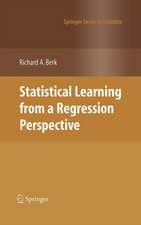Predicting Recidivism Using Survival Models: Research in Criminology
Autor Peter Schmidt, Ann D. Witteen Limba Engleză Paperback – 24 iul 2012
Din seria Research in Criminology
- 15%
 Preț: 639.41 lei
Preț: 639.41 lei -
 Preț: 384.70 lei
Preț: 384.70 lei -
 Preț: 380.07 lei
Preț: 380.07 lei -
 Preț: 381.43 lei
Preț: 381.43 lei - 15%
 Preț: 633.19 lei
Preț: 633.19 lei - 18%
 Preț: 958.38 lei
Preț: 958.38 lei - 5%
 Preț: 712.81 lei
Preț: 712.81 lei -
 Preț: 384.09 lei
Preț: 384.09 lei -
 Preț: 384.86 lei
Preț: 384.86 lei -
 Preț: 379.48 lei
Preț: 379.48 lei -
 Preț: 384.86 lei
Preț: 384.86 lei -
 Preț: 380.07 lei
Preț: 380.07 lei -
 Preț: 390.46 lei
Preț: 390.46 lei -
 Preț: 378.54 lei
Preț: 378.54 lei -
 Preț: 390.84 lei
Preț: 390.84 lei -
 Preț: 383.50 lei
Preț: 383.50 lei -
 Preț: 398.74 lei
Preț: 398.74 lei -
 Preț: 383.93 lei
Preț: 383.93 lei -
 Preț: 387.38 lei
Preț: 387.38 lei
Preț: 635.31 lei
Preț vechi: 747.43 lei
-15% Nou
Puncte Express: 953
Preț estimativ în valută:
121.60€ • 132.13$ • 102.21£
121.60€ • 132.13$ • 102.21£
Carte tipărită la comandă
Livrare economică 21 aprilie-05 mai
Preluare comenzi: 021 569.72.76
Specificații
ISBN-13: 9781461283430
ISBN-10: 1461283434
Pagini: 192
Ilustrații: XI, 174 p.
Dimensiuni: 155 x 235 x 10 mm
Greutate: 0.28 kg
Ediția:Softcover reprint of the original 1st ed. 1988
Editura: Springer
Colecția Springer
Seria Research in Criminology
Locul publicării:New York, NY, United States
ISBN-10: 1461283434
Pagini: 192
Ilustrații: XI, 174 p.
Dimensiuni: 155 x 235 x 10 mm
Greutate: 0.28 kg
Ediția:Softcover reprint of the original 1st ed. 1988
Editura: Springer
Colecția Springer
Seria Research in Criminology
Locul publicării:New York, NY, United States
Public țintă
ResearchCuprins
1 Introduction.- Overview.- Prediction in Criminology.- Ethical Issues.- What Sample Should Be Used to Estimate the Model?.- Selection of a Criterion Variable.- Use and Selection of Explanatory Variables.- Selection of a Statistical Model.- What Are Realistic Goals for Prediction?.- The Career Criminal Paradigm.- Previous Use of Survival Analysis in Justice Research.- Preview of Coming Attractions.- 2 Data.- The Nature of the Data.- Definitions of Variables.- Comparisons of Subsamples.- 3 Survey of Statistical Methodology.- Survival Time Models.- Estimation of Survival Time Models.- Predictions Using Survival Time Models.- 4 Simple Models.- Nonparametric Prediction.- The Exponential Distribution.- The Lognormal Model.- The Log-Logistic Model.- The Weibull Model.- The LaGuerre Model.- Conclusions.- 5 Split Population Models.- The Split Exponential Model.- The Split Lognormal Model.- The Split Log-Logistic Model.- The Split Weibull Model.- The Split LaGuerre Model.- Conclusions.- 6 The Proportional Hazards Model.- The Model and Its Estimation.- Results of Estimation.- Predictions From the Proportional Hazards Model.- Conclusions.- 7 Parametric Models With Explanatory Variables.- Models Based on the Exponential Distribution.- Results for Exponential Models.- Predictions From Exponential Models.- Models Based on the Lognormal Distribution.- Results for Lognormal Models.- Predictions From Lognormal Models.- A Model Based on the LaGuerre Distribution.- Conclusions.- 8 Predictions for Nonrandom Samples and for Individuals.- Predictions Across Release Cohorts.- Subsample Predictions.- Individual Predictions.- Conclusions.- 9 Summary and Conclusions.- Summary.- Conclusions.- References.- Author Index.


















